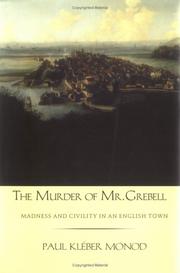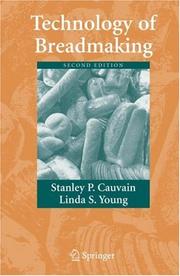| Listing 1 - 10 of 21 | << page >> |
Sort by
|
Book
ISBN: 222202370X 9782222023708 Year: 1979 Publisher: Paris CNRS
Abstract | Keywords | Export | Availability | Bookmark
 Loading...
Loading...Choose an application
- Reference Manager
- EndNote
- RefWorks (Direct export to RefWorks)
Bread --- -Breads --- Baked products --- Cooking (Bread) --- Congresses --- -Congresses --- Breads
Book
ISBN: 1501307452 1501307460 9781501307454 9781501307461 9781501307447 1501307479 Year: 2020 Publisher: London, England : London, England : Bloomsbury Academic, Bloomsbury Publishing,
Abstract | Keywords | Export | Availability | Bookmark
 Loading...
Loading...Choose an application
- Reference Manager
- EndNote
- RefWorks (Direct export to RefWorks)
"Explores bread as both everyday object and as an object that has been invested throughout history with symbolic power and an astonishing variety of social, cultural and figural meanings"--
Bread --- Breads --- Baked products --- Cooking (Bread) --- Cultural studies

ISBN: 1281722189 9786611722180 0300130198 9780300130195 9781281722188 9780300099850 0300099851 6611722181 Year: 2003 Publisher: New Haven : Yale University Press,
Abstract | Keywords | Export | Availability | Bookmark
 Loading...
Loading...Choose an application
- Reference Manager
- EndNote
- RefWorks (Direct export to RefWorks)
On a winter night in 1743, a local magistrate was stabbed to death in the churchyard of Rye by an angry butcher. Why did this gruesome crime happen? What does it reveal about the political, economic, and cultural patterns that existed in this small English port town? To answer these questions, this fascinating book takes us back to the mid-sixteenth century, when religious and social tensions began to fragment the quiet town of Rye and led to witch hunts, riots, and violent political confrontations. Paul Monod examines events over the course of the next two centuries, tracing the town's transition as it moved from narrowly focused Reformation norms to the more expansive ideas of the emerging commercial society. In the process, relations among the town's inhabitants were fundamentally altered. The history of Rye mirrored that of the whole nation, and it gives us an intriguing new perspective on England in the early modern period.
Murder --- Criminal homicide --- Killing (Murder) --- Homicide --- Breads, John, --- Grebell, Allen, --- Criminal law. Criminal procedure --- Grebell, Allen --- Breads, John --- Breads, John, -- d. 1743.. --- Grebell, Allen, -- d. 1743.. --- Murder -- England -- Rye -- Case studies.
Book
ISBN: 0128231912 0128210486 9780128231913 9780128210482 Year: 2021 Publisher: London, England : Academic Press,
Abstract | Keywords | Export | Availability | Bookmark
 Loading...
Loading...Choose an application
- Reference Manager
- EndNote
- RefWorks (Direct export to RefWorks)
Bread. --- Breads --- Baked products --- Cooking (Bread) --- Bread --- Bread industry --- Quality control. --- Production control.
Book
ISBN: 0081025203 008102519X 9780081025192 9780081025208 Year: 2020 Publisher: Kidlington, Oxford, England : Woodhead Publishing,
Abstract | Keywords | Export | Availability | Bookmark
 Loading...
Loading...Choose an application
- Reference Manager
- EndNote
- RefWorks (Direct export to RefWorks)
Bread. --- Bread industry. --- Baked products industry --- Breads --- Baked products --- Cooking (Bread)
Book
ISBN: 9780857095695 0857095692 0857090607 9780857090607 Year: 2012 Publisher: Philadelphia, Pa : Woodhead Pub.,
Abstract | Keywords | Export | Availability | Bookmark
 Loading...
Loading...Choose an application
- Reference Manager
- EndNote
- RefWorks (Direct export to RefWorks)
The first edition of Breadmaking: Improving quality quickly established itself as an essential purchase for baking professionals and researchers in this area. With comprehensively updated and revised coverage, including six new chapters, the second edition helps readers to understand the latest developments in bread making science and practice. The book opens with two introductory chapters providing an overview of the breadmaking process. Part one focuses on the impacts of wheat and flour quality on bread, covering topics such as wheat chemistry, wheat starch structure, grain quality assessment, milling and wheat breeding. Part two covers dough development and bread ingredients, with chapters on dough aeration and rheology, the use of redox agents and enzymes in breadmaking and water control, among other topics. In part three, the focus shifts to bread sensory quality, shelf life and safety. Topics covered include bread aroma, staling and contamination. Finally, part four looks at particular bread products such as high fibre breads, those made from partially baked and frozen dough and those made from non-wheat flours. With its distinguished editor and international team of contributors, the second edition of Breadmaking: Improving quality is a standard reference for researchers and professionals in the bread industry and all those involved in academic research on breadmaking science and practice. With comprehensively updated and revised coverage, this second edition outlines the latest developments in breadmaking science and practice Covers topics such as wheat chemistry, wheat starch structure, grain quality assessment, milling and wheat breeding Discusses dough development and bread ingredients, with chapters on dough aeration and rheology.
Bread. --- Baking. --- Bread industry. --- Baked products industry --- Cooking --- Breads --- Baked products --- Cooking (Bread)

ISBN: 1280863838 9786610863839 0387385657 0387385630 1489987304 Year: 2007 Publisher: New York : Springer,
Abstract | Keywords | Export | Availability | Bookmark
 Loading...
Loading...Choose an application
- Reference Manager
- EndNote
- RefWorks (Direct export to RefWorks)
To study breadmaking is to realize that, like many other food processes, it is constantly changing as processing methodologies become increasingly more sophisticated, yet at the same time we realize that we are dealing with a foodstuff, the forms of which are very traditional. New ideas and raw materials are constantly being presented to bakers from wheat breeders, millers and ingredient and equipment suppliers for their evaluation. In addition there are on-going changes in legislation and consumer demands. To meet such pressures bakers must be able to better integrate their key raw material, wheat flour, with other ingredients and processing methods to deliver bread of the appropriate quality. Technology of Breadmaking, Second Edition, sets out to identify and present the new knowledge that has become available in last 10 years, as well as update information. Like the first edition, it provides a useful tool to help bakers, scientists and technologists to cope with those changes. About the Authors Stanley P. Cauvain is the Director and Vice President of Research and Development activities at BakeTran. Linda S. Young is a Director and Vice President of Knowledge Systemization and Training at BakeTran. .
Bread. --- Baking. --- Bread industry. --- Baked products industry --- Cooking --- Breads --- Baked products --- Cooking (Bread) --- Food science. --- Food Science. --- Science --- Food—Biotechnology.
Book
ISBN: 9783875489897 3875489896 Year: 2020 Volume: 22 Publisher: Hamburg : Helmut Buske Verlag,
Abstract | Keywords | Export | Availability | Bookmark
 Loading...
Loading...Choose an application
- Reference Manager
- EndNote
- RefWorks (Direct export to RefWorks)
In den meisten modernen Kulturen wird Brot in der einen oder anderen Form als Grundnahrungsmittel angesehen. Dasselbe gilt für das Altertum, insbesondere für Ägypten. Dieses Interesse an Brot ist in der ägyptischen Sprache besonders wahrnehmbar, indem sie mehr als hundert verschiedene Brotnamen hervorbringt, die in einer Vielzahl von Dokumenten vorkommen. Der erste Teil dieser Monographie widmet sich der lexikographischen Analyse von vierundvierzig Brotbezeichnungen und deren Entwicklung von der Frühdynastischen Periode bis zum Ende des Neuen Reiches, mit verschiedenen Ausflügen in die Dokumentation der späteren Perioden. Einige der erforschten Begriffe gehören zu den bekanntesten der ägyptischen Kultur, bei denen jeweils die Graphien, Determinative und Wurzeln detailliert untersucht wurden sowie die Bedeutung dieser Brotnamen in den religiösen, königlichen und administrativen Texten. Diese Einzelanalysen bilden die Grundlage für die Entwicklung mehrerer Synthesen, die im zweiten Teil der Arbeit vorgestellt werden. Sie untersuchen breitere Themen wie die Ausarbeitung einer taxonomischen Hierarchie der Backwaren, die Analyse der Brotdeterminative in den Quellen der Frühdynastischen Periode und des Alten Reiches oder die Einflüsse der technischen Evolution der ägyptischen Backpraktiken zwischen dem Alten und Mittleren Reich auf die damaligen Brotsorten.
Bread --- Egyptian language --- Terminology --- Vocabulary --- Breads --- Baked products --- Cooking (Bread) --- Afroasiatic languages --- Bread - Terminology --- Egyptian language - Vocabulary
Book
ISBN: 5020177091 Year: 1996 Publisher: Moskva Vostočnai︠a︡ literatura
Abstract | Keywords | Export | Availability | Bookmark
 Loading...
Loading...Choose an application
- Reference Manager
- EndNote
- RefWorks (Direct export to RefWorks)
Slavs --- Marriage customs and rites --- Bread --- Slaves --- Mariage --- Pain --- Folklore --- Rites et cérémonies --- Rites et cérémonies --- Marriage customs and rites, Slavic --- Breads --- Baked products --- Cooking (Bread)
Book
ISBN: 9053569782 9786611979164 1281979163 9048507650 9789053569788 Year: 2007 Publisher: Amsterdam : Amsterdam University Press,
Abstract | Keywords | Export | Availability | Bookmark
 Loading...
Loading...Choose an application
- Reference Manager
- EndNote
- RefWorks (Direct export to RefWorks)
Met deze uitspraak van de Hongaarse schrijver György Konrad opende 'Nauwgezet en Wanhopig' van Wim Kayzer - een legendarische tv-serie vooral bekend bij literatuurliefhebbers. In de vele manieren waarop we zin en betekenis zoeken blijkt het narratieve een belangrijke rol te spelen. Soetaert presenteert een (b)logboek waarin hij de vraag 'wat is een verhaal' vervangt door 'wat wordt er over verhalen in verhalen verteld'? Het antwoord zoekt hij in boeken en films, in hoge en lage cultuur, in woord en beeld, in computergames en soaps... En last but not least: op het Internet als een nieuwe verhal
Bread. --- Fiction. --- Novelle. --- Nouvelles --- Novellas (Early literary form) --- Fiction --- Metafiction --- Novellas (Short novels) --- Novels --- Stories --- Breads --- Philosophy --- Narrative poetry --- Literature --- Novelists --- Baked products --- Cooking (Bread)
| Listing 1 - 10 of 21 | << page >> |
Sort by
|

 Search
Search Feedback
Feedback About UniCat
About UniCat  Help
Help News
News